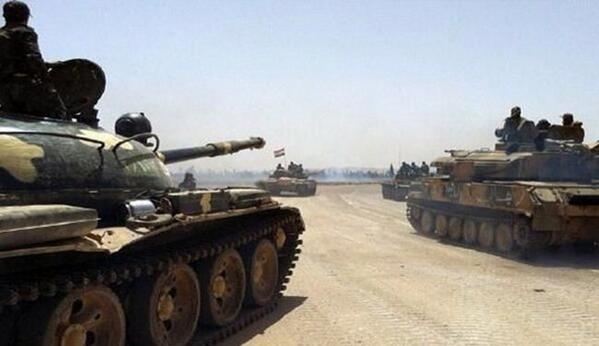The process of tightening the grip around the armed groups’ last strongholds in Yabroud in Qalamoun Mountains is taking place...
Hussein Mallah
The process of tightening the grip around the armed groups' last strongholds in Yabroud in Qalamoun Mountains is taking place, in concurrence with an appeal by the leaders of these groups for their certainty of losing the battle against the Syrian Army, in the middle of calls for opening a new front in order to occupy the Army in Qalamoun.

Yabroud is the last stronghold for militants in Qalamoun
The ongoing battles in Yabroud reveal the Army's determination to finish what it had initiated a couple of months ago which is to put an end to the threat the militants taking Qalamoun Mountains as shelters imposes. The Army is seeking to either regain control over some regions in specific (Qara, Deir Atieh, Nabak, and lately Jarajeer and Rima heights), or to impose a siege and block the way on supplies reaching armed groups in Yabroud, Assal Al-Ward, and later Rankus...
The strategy of "taking control with fire" and "gradual gnawing" which the military units in Yabroud and its surrounding are following left great geographic, material, and life losses among the armed groups, according to the opposition itself which assured Monday night the killing of a significant leader, while the official media reported that several leaders were killed including leader of the so-called "Islamic Front" Abu Malek, leader of the "Internal Security" militia, Samir Nasrallah, Financier and operations leader in the region Mahmoud Arouq, known by Abu Ali Al-Yabroudi, and leaders of the "Free Ones of the Levant" brigades, Anas Abboud and Methqal Hamamah.
The Army's strategy has proved its success until today and the evidence to that are the warnings of the "Free Army" and the Arab media supporting them regarding the definite loss of Qalamoun battle if the situation remained the same, and their call for opening a new front to reduce pressure on Yabroud militants.
Daraa once again...
 In a previously published report about Daraa, there were information about a Western-Saudi effort to ignite the southern front, that is Daraa, for several reasons, including its close distance from Damascus and the easiness of supplying militants there with military and logistics support. In this context, western information had revealed that training camps were established in Jordan under Western supervision and Gulf funding, not to mention the intelligence information that Israeli observatories in Golan heights could supply.
In a previously published report about Daraa, there were information about a Western-Saudi effort to ignite the southern front, that is Daraa, for several reasons, including its close distance from Damascus and the easiness of supplying militants there with military and logistics support. In this context, western information had revealed that training camps were established in Jordan under Western supervision and Gulf funding, not to mention the intelligence information that Israeli observatories in Golan heights could supply.
To assure that, observers had talked about the involvement of all those parts in the armed groups' attack on Army locations in eastern Ghouta late November. Back then, information stated that the attack, which thousands of militants took part in, aimed at breaking the siege imposed on militants' strongholds in eastern Ghouta, cutting Damascus airport road, and restoring the threat which was imposed on the capital through its southern gate.
Militants who came from the southern region took part in this attack under Western intelligence support and Arab funding (reports about Saudi Intelligence Chief, Bandar bin Sultan's personal involvement were spread). Information revealed then that the Syrian Army frustrated an attempt to transport a convoy of 100 trucks carrying arms and munitions to the militants in eastern Ghouta.
The significance here is that the attack on Ghouta was in concurrence with the beginning of the Qalamoun battle and the control of the Syrian Army over Qara city. In other words, Ghouta front was opened in attempt to occupy the Army from targeting militants' strongholds in Qalamoun.
Based on that, sources following up the track of field operations do not exclude the possibility that armed groups try, with foreign direction and support, to occupy the Army from the southern region.
In fact, militants on Monday tried to advance to the strategic town of Kherbet Ghazaleh in order to control it and cut the supply road between Army units, but it was a failed attempt frustrated by the Syrian Army.
A couple of days earlier, armed groups also tried to create confusion inside the Army in Qunaitra by taking control over several towns, but this did not last long as the Army instantly regained them.
All these developments on ground were followed by changes in the leadership of the so-called "Free Syrian Army" along with the removal of Brigadier General Salim Idriss from his position as Chief of Staff and his replacement with escaped general Abdel Ilah Al-Bashir.
Even if these changes were mostly related to the clash of axes and local and regional power inside the opposition council and the armed groups related to it, what mattered was that General Bashir headed the military council in Qunaitra, South of Syria, and seceded from the Army in 2012. Hence, his appointment was an attempt by the council to give a push to the militants in the southern region to prepare them for what could take place in the near future.
What is certain is that the Syrian military leadership is cautious about any developments or unexpected surprises in the southern front, and it is taking seriously the threats of the armed groups and the Western and Arab parts supporting them, who seek for making Daraa Damascus's soft side...
Translated by Sara Taha Moughnieh